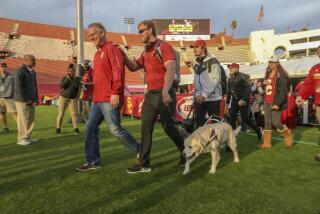8 Best Friends Guided His Life
- Share via
Wilber Thornton has had 18 eyes to guide him and only two of them let him down.
Those were his own. The 78-year-old San Marcos man was blinded during his high school days, when a tire exploded in his face in Escondido. A few years later, he became one of the first Californians to receive a guide dog. That was back in 1935.
This year he claimed the title as longest continuous owner of guide dogs worldwide. He was among the first class of Californians to be trained by the Seeing Eye Foundation with specially trained dogs, but until a year or so ago, “some guy from the East held the title.”
“The other guy retired his last dog about five years ago, after 53 years,” Thornton said. “I could have claimed the title more than a year ago but I waited until now, just to be sure.”
Eight Seeing Eye dogs have guided Thornton to his present title; he still has a clear memory of all of them.
The first was Hebe, a female German shepherd, “which was all they used back in those days. They didn’t spay them either, which caused all sorts of problems. They thought that spaying made them dumb and fat, which turned out to be an old wives’ tale.”
Thornton and Hebe met in Oakland in January, 1935, where they and the rest of that first Seeing Eye dog class convened in an Oakland hotel to get to know each other.
“We lived together, all day and all night. We walked around Oakland together and I remember the streetcars clanging up and down the street. Some of the guys got lost, but I have a good sense of direction. That is important. Almost as important as a sense of humor.”
Since those first days in 1935, Thornton has lived a nearly normal life, depending on his series of guide dogs to provide him with the sight he lost so suddenly.
“Actually, it wasn’t losing my sight that was such a shock,” Thornton said. “It was losing all my friends.
“Everyone just dropped me. That was the hardest part. It was as if I wasn’t there. They would talk about me to someone as if I didn’t exist, as if I was invisible.”
The public’s attitude toward the blind has improved over the past half century, he said, “but people still shout at me, as if I was deaf, not blind. And people come up and try to play games, asking me to guess who they are. They even disguise their voices and try to fool me.”
Thornton doesn’t think it’s funny. But he never says so.
Thornton was married twice, has a son and three grandchildren. His present wife, Sally, has been in a rest home for two years.
In those early days in Escondido, where Thornton moved in 1921, he completed high school and, a decade later enrolled in Palomar College, where he took courses in creative writing, ecology, philosophy and history. He never graduated because, he explained, “I wasn’t interested in that, in a degree. I was taking courses that I wanted to take.”
He was the first blind student to graduate from Escondido High School and the first blind student to enroll in Palomar College. Thornton and Hebe ran a sundries store, what in modern days would be a 7-Eleven, in Escondido between his high school and college days. It was a little place selling little things--soda pop, ice cream, tobacco products, candy--with a couple of pinball machines in the back.
“The pinball machines were the only things that made money,” Thornton recalled. “And Hebe was a good watchdog, wouldn’t let anybody get behind the counter. Guide dogs aren’t supposed to do that. But she took it upon herself to guard the counter and not let anybody but me behind it.”
Then World War II came along, bringing shortages in everything he sold, “and all the guys that played the pinball machines were away in the service,” so Thornton was forced to close up shop.
He joined the war effort himself, car-pooling from Escondido to Convair in San Diego, where he worked assembling survival kits for aircraft crews. He got the job, he said, because the aircraft firm had had losses from other employees who stole the scissors and knives and other metal parts out of the kits. He and Peggy, his second dog, commuted daily to the job and home again to his family in Escondido.
Peggy, another female German shepherd, was a very shy dog, Thornton said. “She never barked, she never was a problem, not that any of my dogs were.”
“People think that Seeing Eye dogs are superdogs. They are not. Dogs are just dogs. People think that you just tell a dog to ‘go home’ or ‘go to the store,’ but you don’t. You tell them to go or stop or go right or left, but they don’t do anything you don’t tell them to do.”
After Peggy, there was Tweed, then Carrie, and Duke, Thornton’s first black Labrador. Duke developed a very undesirable habit, Thornton recalled. He refused to relieve himself in the back yard, waiting until he was out on the street, with Thornton in tow.
“I left him in the yard for two days once and he wouldn’t go, not ‘til I took him out on the street. I finally had to send him back,” to the training center, “and they said they could handle it.”
Next came Adair, who was a fine dog but developed eye trouble--a rarity for canines--and had to be retired from the service for obvious reasons. Eagle was next, “the most perfectly marked German shepherd,” who served Thornton well for about eight years, and finally, Toto, his present companion.
He won’t pick a favorite among his guide dogs, saying only that “each one is the best when he’s here,” and Thornton admits that his canine friends have become very dear to him and difficult to part with.
Just the other day, Toto, a black Labrador, departed for about six hours on a visit to the vet and a well-deserved flea bath.
“I missed him a lot,” Thornton confessed. “No one to talk to. It was like part of me was gone.”
Toto, who is getting a little white around the muzzle, is 10 1/2 years old, not all that far from Thornton’s age in dog years.
“The trainer was out the other day and he said that Toto was in the best shape he’d seen for a dog of his years,” Thornton said. “I don’t think I’d bet on which one of us will go first, him or me.”
More to Read
Sign up for Essential California
The most important California stories and recommendations in your inbox every morning.
You may occasionally receive promotional content from the Los Angeles Times.










